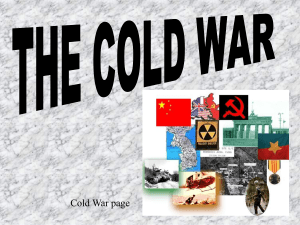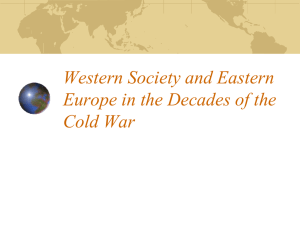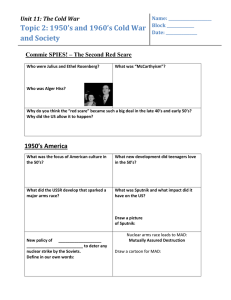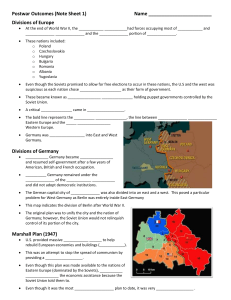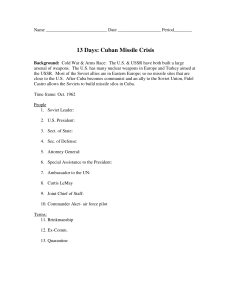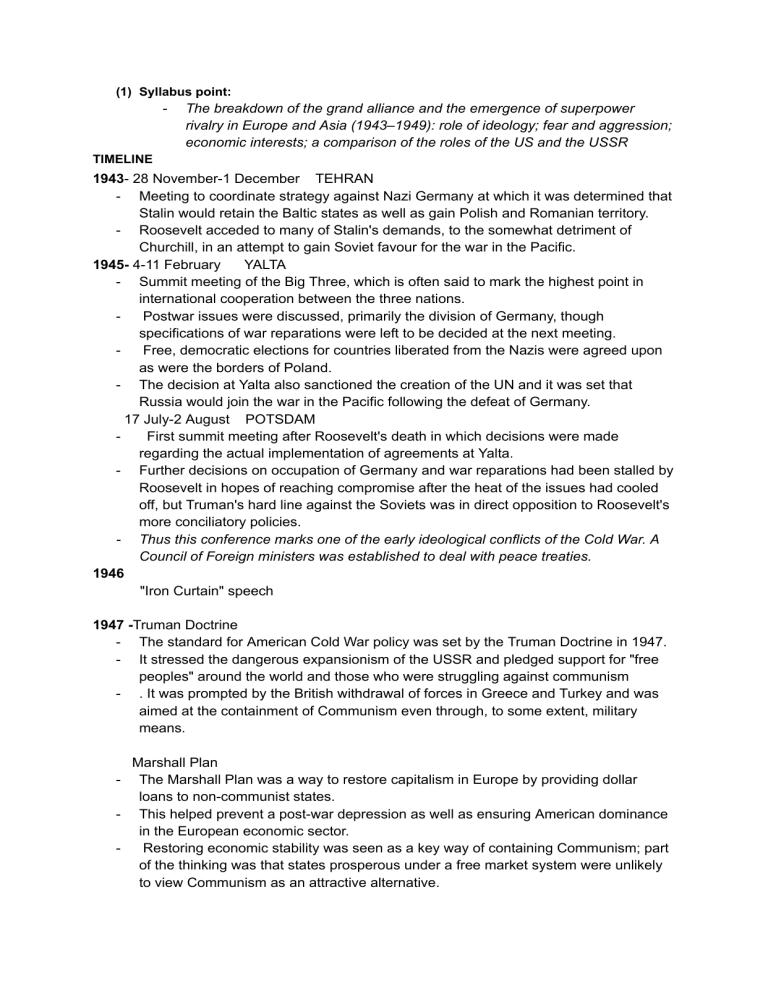
(1) Syllabus point: - The breakdown of the grand alliance and the emergence of superpower rivalry in Europe and Asia (1943–1949): role of ideology; fear and aggression; economic interests; a comparison of the roles of the US and the USSR TIMELINE 1943- 28 November-1 December TEHRAN - Meeting to coordinate strategy against Nazi Germany at which it was determined that Stalin would retain the Baltic states as well as gain Polish and Romanian territory. - Roosevelt acceded to many of Stalin's demands, to the somewhat detriment of Churchill, in an attempt to gain Soviet favour for the war in the Pacific. 1945- 4-11 February YALTA - Summit meeting of the Big Three, which is often said to mark the highest point in international cooperation between the three nations. Postwar issues were discussed, primarily the division of Germany, though specifications of war reparations were left to be decided at the next meeting. Free, democratic elections for countries liberated from the Nazis were agreed upon as were the borders of Poland. - The decision at Yalta also sanctioned the creation of the UN and it was set that Russia would join the war in the Pacific following the defeat of Germany. 17 July-2 August POTSDAM First summit meeting after Roosevelt's death in which decisions were made regarding the actual implementation of agreements at Yalta. - Further decisions on occupation of Germany and war reparations had been stalled by Roosevelt in hopes of reaching compromise after the heat of the issues had cooled off, but Truman's hard line against the Soviets was in direct opposition to Roosevelt's more conciliatory policies. - Thus this conference marks one of the early ideological conflicts of the Cold War. A Council of Foreign ministers was established to deal with peace treaties. 1946 "Iron Curtain" speech 1947 -Truman Doctrine - The standard for American Cold War policy was set by the Truman Doctrine in 1947. - It stressed the dangerous expansionism of the USSR and pledged support for "free peoples" around the world and those who were struggling against communism - . It was prompted by the British withdrawal of forces in Greece and Turkey and was aimed at the containment of Communism even through, to some extent, military means. Marshall Plan - The Marshall Plan was a way to restore capitalism in Europe by providing dollar loans to non-communist states. - This helped prevent a post-war depression as well as ensuring American dominance in the European economic sector. Restoring economic stability was seen as a key way of containing Communism; part of the thinking was that states prosperous under a free market system were unlikely to view Communism as an attractive alternative. Major Events 1948-Berlin Blockade/Airlift - Czechoslovakia separated from USSR - Tito starts the idea of non-alignment by having a Communist government that is separate from the Soviets. 1949- NATO formed, military and political alliance formed to protect and defend Western Europe from Soviet attack End of Berlin Blockade 12 May 1949 after the West had agreed to a reconvening of the Council of Foreign Ministers to discuss the "German question" post-establishment of the FRG Basic Law (8 May 1949). - FRG formed - Soviets Test A-bomb - GDR granted nominal independence 1 October-PRC proclaimed 1950- US launches H-bomb development McCarthyism Rosenbergs arrested 1951- US tests first H-bomb 1953- Soviets test first H-bomb 1954 - IN Guatemala The CIA helps bring into power a right-wing military junta - Relations normalized in Western Europe Postwar occupation by Britain, France and the US ends 7 May - Dien Bien Phu - French defeat; France agree to pull out on 20 July 1955- 14 May Warsaw Pact formed Nasser buys eastern bloc arms 1956- USA and Britain withdraw financial aid for Aswan Dam - Nasser nationalizes the Suez Canal (Distracts West from Hungary) - Suez Crisis (29 October) - France, Britain, and Israel attack Egypt. - Cease-fire in Suez conflict after UN pressure - Hungarian Revolution (Distracts USSR from Egypt) Reformist Communist Imre Nagy is brought back as Prime Minister in a popular uprising. -Warsaw Pact troops invade Hungary -The USSR appoints Kádár as head of government 1957 4 October - Sputnik launched - FNLA established US supports this guerilla group to fight for a non-communist, independent Angola 1958- Kádár's hardline Soviet government hangs Nagy 1959- Castro rules Cuba - Kitchen Debates 1960- 1 May U-2 Incident - Just before a summit meeting to take place in Paris, the Soviets shot down one of the American U-2 spy planes. Khruschev denounced American aggression and threatened to retaliate in Norway, Pakistan, and Turkey where other U-2's were based. F - ollowing the hostile summit, US-USSR relations were frozen for the remainder of Eisenhower's term. - Vietcong (NLF) formed Guerrilla force to liberate South Vietnam from US-backed government 1961- Bay of Pigs US attempt to remove Castro fails because it does not gain the support of locals as had been anticipated 13 August - Berlin Wall - Built by the GDR to stop the mass exodus of its citizens - 1962- Cuban Missile Crisis - October 16-28: Khruschev placed nuclear missiles in Cuba in an attempt to counter US numerical superiority. Of course, he claimed that it was to prevent an American invasion and was thus defensive action. - President Kennedy decided on 22 October that the best course of action would be to place a blockade around the island, relying on the belief that the missiles were not yet operational and equipment was still in the process of being sent to Cuba. Six days later the Soviets agreed to remove the weapons and it is now known that Kennedy had entered into a secret agreement to not invade Cuba. Often called the beginning of the end of the Cold War. 1963-"Ich bin ein Berliner" Pol Pot builds up the Khmer Rouge and Cambodian Communist Party - Limited Test Ban Treaty - Banned atmospheric testing 1964-Gulf of Tonkin Incident - Alleged attack by the North Vietnamese on the destroyers USS Maddox and USS Turner Joy on 2 and 4 August of 1964. Leads to increased American involvement in the Vietnam War. 1968- Prague Spring - Dubcek started a programme of political reform in the Spring of 1968 and installed more personal freedoms in Czechoslovakia, but this only lasted for a very brief period of time as he was arrested in August and 650,000 Soviet troops occupied the country to bring it back to Soviet Communism. 26 September Brezhnev Doctrine Soviet foreign policy justifying the invasion of Czechoslovakia under the Warsaw Pact. It stated that the Communist parties were to have dominance in their respective states –under leaders approved in Moscow. If these conditions were put in jeopardy, neighboring socialist states were obligated to intervene. The PRC labeled this as imperialism. The Brezhnev Doctrine was loosened under Gorbachev to allow for his reforms. It was eventually dropped all together on 25 October 1989. 1969 Ostpolitik The direction of foreign policy adopted by the Federal Republic of East Germany in 1969 aimed at improving relations with Eastern Europe. It reversed the Hallstein Doctrine under which the FRG refused to have diplomatic relations with any state that recognized the GDR. "Ostpolitik" became official FRG policy in 1969 and in addition to increasing trade opportunities it was to reduce the reliance on US military aid. 25 July Vietnamization begins 30 November Nixon agrees to pull out of Vietnam 1971 PRC admitted into UN 1972 SALT I Signed by Nixon and Brezhnev, set limits for each country's ballistic missile defense and froze deployment of ICBM launchers. ABM Treaty The ABM Treaty constrains strategic defenses to a total of 200 launchers and interceptors, 100 at each of two widely separated deployment areas. These restrictions are intended to prevent the establishment of a nationwide defense or the creation of a base for deploying such a defense. The treaty also codifies the principle of "non-interference" by one party with the national technical means of verification of the other, thereby protecting the right of overflight by reconnaissance satellites. This becomes obsolete quickly as technological advancements made Anti-Balistic Missiles themselves obsolete. MIRVs increased the chances of being able to destroy the other side's strategic force and thus that side's ability to retaliate following an attack. 1975 Helsinki Accords 1.) free determination -human rights -inviolable frontiers -advance notification of large-scale military manœuvres. 2.)East-West cooperation in economics, science, technology, the environment, and trade 3.)Humanitarian cooperation -free flow of people, information, and ideas 1979 16 July Iranian Revolution outs the Shah, a US ally. SALT II Signed by Carter and Brezhnev. Limited the number of strategic missile launchers and other such systems that each country could deploy. Even though SALT II was never actually ratified by the US Senate, it was generally adhered to by both countries. 17 July Nicaragua Sandinistas overthrow the pro-US Somoza government December Soviet invasion of Afghanistan Marks the end of the Brezhnev Thaw 1980 January Rapid Deployment Force Created in response to events in Afghanistan, Carter moves toward a policy of "mobile response." "any attempt by any outside force to gain control of the Persian Gulf region will be regarded as an assault on the vital interests of the USA and such an assault will be repelled by any means necessary." July Presidential Directive 59 Carter increases military spending Solidarity Anti-communist trade union started in Poland. 1981 INF Talks Deadlocked talks for cutting intermediate-range missiles in Euroe. Terminated by Soviet Union in '83 START Strategic Arms Reduction Talks calling for deep cuts in total nuclear weapons. Rejected in '83 as it would have cut deep into Soviet land-based missiles (the heart of their weapons), while allowing the US to keep modernizing their strategic triad (ICBMs, SLBMS, and manned strategic bombers) 1983 SDI aka Star Wars Development of IBM Defense systems that will be deployed from Outer Space to destroy Soviet missiles in flight. -potential to give US the confidence to launch a pre-emptive first strike -Reagan says it was to boost up the arms race into making Soviets ruin their economy by stockpiling. (Only thing is, it was cheaper for the Soviets to do that than the cost of SDI) "Zero Option" US offers to cancel planned deployment of Pershing II IRBMs and Tomahawk cruise missiles if the Soviets dismantle all intermediate range missiles in Europe and elsewhere. Soviets reject this because they *just* deployed SS-20s and it would also still leave US forward-based systems and the nuclear forces of France and Great Britain. Reagan declares support for Contras 25 October Grenada US invades Grenada after the New JEWEL Movement's (somewhat Marxist-Leninist) leader is assassinated. JEWEL had planned on building an airport to help with tourism, but US viewed this as a threat because it would be used by Cuba and the USSR as well, in exchange for financial aid. The US holds elections, but the action was condemned by the UN. 1985 Glastnost and Perestroika Gorbachev comes to power (March) and launches Glasnost (open debate on government policies) and Perestroika (economic restructuring). Realizes that military spending is crippling the Soviet economy, so he works hard at getting arms control so that he can go on with plans to restore the economy. 1986 Iran-Contra Scandal May 1 1984: Congress decides to cut aid to the Contras in Nicaragua (Contra- CIA sponsored forces in Nicaragua fighting the Communist Sandinistas) Reagan administration uses profits from illegal sale of arms in Iran to secretly fund Contras. Exposed in 1986. Reagan not incriminated but many of his top aides resign and are later convicted. 1987 April Gorbachev accepts the 1981 "zero option" (intermediate range) and proposes "double zero" (short range). December INF Treaty First arms reduction agreement. 1989 February Soviets pull out of Afghanistan 20 May Tiananmen Square protest crushed by government Poland =non-communist Elections bring the Solidarity movement to the head of the coalition government November Berlin Wall Falls Czechoslovakia =non-communist Romania =non-communist Only country in Eastern Europe to have bloodshed in the fall of their Communist government as dictator Ceausescu and wife are executed in an uprising 1990 3 October Germany Reuinited 2 December –Free all-German elections held (first time since 1932) 1991 1 July Warsaw Pact dissolved Soviets cut arms shipments to Afghanistan (former Soviet Afghan government falls in April 1992)
